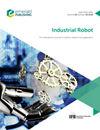Guest editorial: Dexterous manipulation
IF 2.5
4区 计算机科学
Q3 ENGINEERING, INDUSTRIAL
Industrial Robot-The International Journal of Robotics Research and Application
Pub Date : 2022-06-01
DOI:10.1108/ir-06-2022-460
引用次数: 0
Abstract
Compliant and dexterous manipulation forms the basis for efficient robotic interaction in dynamic and unstructured environments. When manipulators are deployed in a dynamic and unstructured environment, they are required to have more adaptivity and dexterity in addition to high precision control. Although we have seen many promising robotic manipulations in well-controlled laboratory environments, compliant dexterous manipulation, as an essential robotic skill that can be applied in a less strict scenario, e.g. in a living room, is far from being solved. The remaining problems motivate researchers to develop advanced technologies that combine optimized design, intelligent perception, interaction and learning to fill the gap between manipulation theory and its application in the real world. As one of the most important motion interfaces, human hands endow human dexterity when interacting with external environments. It is the life-long mission for many robotic scientists and engineers to develop a human-like dexterous robotic hand. However, there exist many R&D challenges for such robotic hands in regard to mechanical structure, modal fusion and control-learning aspects. First, from the robotic hand designing aspect, the developer needs a balance between the hand’s light weight and the volume to accommodate all required actuators, sensors and mechanics to realize humanlike motion. Second, from the perception aspect, how to design the robust state observer by fusion multimodality feedback is an open challenge, especially when the environments and the given tasks are dynamic. Finally, promising off-the-shelf AI approaches cannot be quickly transferred to the robot control domain. The learning-based method requires a large amount of data, which is not readily available for contact-richmanipulation tasks. This special issue includes the most cutting-edge research results on the abovementioned problems. It contains six research articles that present the newest research achievements regarding the above challenges: The first two focus on dexterous hand design. The third and fourth ones are on perception recognition. The remaining two papers study control and learning. The first paper (Bai et al., 2022) proposes a humanoid robot hand that could wear spacesuit gloves and thus performed measurements. The robot hand consisted of five modular fingers and a parallel wrist driven by a linear motor. Compared with traditional robotic hands, the fingers and wrist were fitted into a spacesuit glove and assembled inside. The humanoid design boosted the dexterity performance of the robotic hand. With the simplification of design and control, the minimalist design radically reduced the complexity of the system and improved the dexterity of the hands. The second paper (Liu et al., 2022) proposes a soft actuator with a sponge-based actuating structure and a layer-jammingbased stiffness to improve the structure in a cavity. The soft actuator was bent under vacuum pressure, and the jamming layers were strongly coupled through friction under vacuum pressure to increase the stiffness of the entire actuator. The flexible and variable-stiffness design improved the grasping ability of fragile objects. The third paper (Zhang et al., 2022) presents a vision-based tactile sensor and a visual–tactile recognition framework to reduce the uncertainty of the visual recognition of transparent objects. The tactile sensor was embedded into the palm of a dexterous hand. Multimode fusion recognition efficiency was improved by integrating the multitask learning model and level-regional feature extraction network. The work is expected to provide high-quality feedback information for improving dexterous manipulation. The fourth paper (Zhai et al., 2022) proposes a novel intelligent impedance control system to ensure accurate position and force control of a massage robot upon human skin with unknown characteristics. By introducing a skin dynamic model, force-deformation on the human body was treated as feed-forward force control. Particle swarm optimization method and graph-based knowledge transfer learning were combined to improve the accuracy and convergence of identification results. The fifth paper (Wu et al., 2022) proposes a cascaded convolutional neural network (CNN) for robotic grasping to adapt to dynamic grasping processes and deal with uncertain grasping information. The CNN was based on monocular vision and a small data set of scattered parts. By using object detection, monocular depth estimation and key point estimation, a successful and sustainable grasping strategy was developed. The work has an impressive grasping success rate. The sixth paper (Wang et al., 2022) introduces a novel scalable and practical modular dexterous hand, which adopts a modular finger and palm design, fully-actuated joint and tactile sensors, can improve the dexterity for robotic manipulation and lower the complexity of maintenance. This work helps in the research of robotic manipulation. These six articles are strictly selected based on many submissions. We hope they could provide helpful knowledge to our readers and promote state-of-the-art studies in dexterous hand design and compliant and dexterous manipulation.嘉宾评论:灵巧的操作
这项工作有助于机器人操作的研究。这六篇文章是在众多投稿的基础上严格挑选出来的。我们希望他们能为读者提供有用的知识,并促进灵巧手设计和柔顺灵巧操作的最新研究。
本文章由计算机程序翻译,如有差异,请以英文原文为准。
求助全文
约1分钟内获得全文
求助全文
来源期刊
CiteScore
4.50
自引率
16.70%
发文量
86
审稿时长
5.7 months
期刊介绍:
Industrial Robot publishes peer reviewed research articles, technology reviews and specially commissioned case studies. Each issue includes high quality content covering all aspects of robotic technology, and reflecting the most interesting and strategically important research and development activities from around the world.
The journal’s policy of not publishing work that has only been tested in simulation means that only the very best and most practical research articles are included. This ensures that the material that is published has real relevance and value for commercial manufacturing and research organizations. Industrial Robot''s coverage includes, but is not restricted to:
Automatic assembly
Flexible manufacturing
Programming optimisation
Simulation and offline programming
Service robots
Autonomous robots
Swarm intelligence
Humanoid robots
Prosthetics and exoskeletons
Machine intelligence
Military robots
Underwater and aerial robots
Cooperative robots
Flexible grippers and tactile sensing
Robot vision
Teleoperation
Mobile robots
Search and rescue robots
Robot welding
Collision avoidance
Robotic machining
Surgical robots
Call for Papers 2020
AI for Autonomous Unmanned Systems
Agricultural Robot
Brain-Computer Interfaces for Human-Robot Interaction
Cooperative Robots
Robots for Environmental Monitoring
Rehabilitation Robots
Wearable Robotics/Exoskeletons.

 求助内容:
求助内容: 应助结果提醒方式:
应助结果提醒方式:


